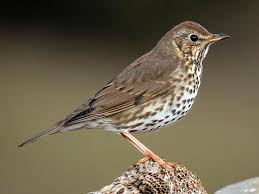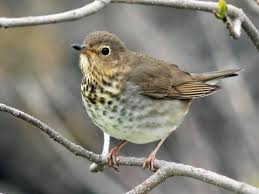Mistle Thrush and Other Turdidae Family Members

Mistle Thrush
Photo Credit – British Trust for Ornithology
This month, I am focusing on a bird I observed during my childhood in northern England: the Mistle Thrush. In the late 1950s, my ornithological colleagues at Bootham School reported that the Mistle Thrush was widely distributed and common around York. I discovered it is absent from North America except for rare winter sightings, but the Continent has its own thrushes, such as the Swainson’s Thrush, Varied Thrush, Hermit Thrush, and the Wood Thrush in the east.
The Mistle Thrush’s diet includes mistletoe berries, hence its name. In winter, it protects clumps of mistletoe berries and, after eating them, carries and deposits their seeds onto trees, propagating the plant. Different species of mistletoe exist worldwide, including in North America. Bluebirds, Mourning Doves, Grosbeaks, and American Robins (also a member of the Turdidae Family) are among the birds responsible for propagating the plant.

Photo Credit – Jose Luis Pelaez, The Pioneer Woman
Mistletoe originates from Anglo-Saxon words mistel for dung, and tan for stick or twig. It has a long history with humans. Originally, it was a medicine and aphrodisiac, but these purposes were eventually replaced by kissing under the mistletoe at Christmas. Norsemen stole a kiss from any woman standing under the mistletoe, and refusing the kiss was bad luck. In England, young girls put mistletoe leaves under their pillows at night when they supposedly dreamt about a particular boy. During the 18th century, the tradition of kissing under the mistletoe at Christmas to bring good luck and peace to the household was established.

Mistle Thrush Range Map
Photo Credit – Observatoire Europeen
Green – resident; Orange – breeding/migrant; Blue non-breeding
The Mistle Thrush is 11 inches long (29 cm) and slightly larger than an American Robin. Most are residents, although some of those breeding in the north and Asia migrate for winter. Distinctive features of the species are:
- Both sexes appear alike: pale grey-brown upperparts with rounded black spots on pale yellow to off-white underparts. Posture upright, and the bird bounds across the ground
- Chosen habitat is woodland, parks, forests, hedges, and pastures, where it finds its diet of berries, seeds, fruit, slugs, snails, worms, and insects.
- The male is loud and melodious. Nicknamed the rain bird, it can be heard singing long distances from the tops of trees in wet, windy, miserable weather conditions.
- Usually, birds are only seen singly or in pairs, although they may merge into flocks of 50 or so in late summer.
- Birds nest early, starting late February to mid-March; the female builds the nest, and the male keeps away intruders; two clutches are laid, each 3 to 5 eggs.
- The typical life span is three years, but five to ten years is not unusual.
The global population of the Mistle Thrush is between 12 and 30 million, nearly two-thirds of which live in Europe. However, numbers have declined in the UK by around 60 percent since the mid-1960s, and consequently, it is on Britain’s most endangered species list. Reasons for the decline are unclear; high juvenile mortality rates are suggested, but the loss of food sources as grassland and woodland are converted to arable may be another cause.

Eurasian Song Thrush
Photo Credit – eBird

Song Thrush Range Map
Photo Credit – Cornell Lab., Birds of the World
Orange – breeding; Purple – year-round; blue – non-breeding
In Europe, you may mistake a Song Thrush for the Mistle Thrush. The Song Thrush is much smaller, its chest speckles are streaky, its upperparts are olive-brown, and it is much more frequently found in backyards.
Let me now turn my attention to North American thrushes.

Swainson’s Thrush
Photo Credit – Cornell Lab., All About Birds

Swainson’s Thrush Range Map
Photo Credit – Cornell Lab., All About Birds
Orange – breeding; Yellow – migration; Blue – non-breeding
The Swainson’s Thrush is familiar during summer along the Pacific coast in northern California. Usually, you hear it before you see it since it hides among the foliage. Its song is distinctive and beautiful, a fluting sound reverberating in dense foliage. The species is common and widespread in North America, with a population of around 12 million. During winter, Swainson’s Thrushes may move to Mexico and further south. It eats a diet of berries and insects, sometimes catching the latter in flight. The bird is smaller than an American Robin, has a round head, a short straight bill, and upperparts are olive-brown, with palish underparts and a brownish spotted chest.

Hermit Thrush
Photo Credit – eBird

Hermit Thrush Range Map
Photo Credit – Cornell Lab., All About Birds
Orange – breeding; Yellow – migration; Blue – Non-breeding
Hermit Thrushes are small, inconspicuous birds widely distributed across North America. Their breeding habitat is dense, moist, upland coniferous forests, but they sometimes move to lower elevations for winter. It is small, greyish brown, with big dark eyes and a reddish tail. Most notable is its song, regarded by some as the most beautiful song of any North American songbird. It eats by foraging among leaf litter on the ground. To distinguish it from a Swainson’s Thrush, look for a more olive-colored back without a cinnamon tail.

Varied Thrush
Photo Credit – Wild Birds Unlimited
Finally, there is the brightly colored Varied Thrush. It breeds in dark, wet, mature forests in the Pacific Northwest, from Alaska to northern California, and migrates to lower altitudes in winter. Sometimes, it can be seen on the ground around bird feeders as it sorts out discarded seeds and eats suet, mealworms, and fruit. The global population is about 35 million, with a one-third decline in numbers during the past 50 years. Try not to confuse the species with the American Robin.
I could mention many other thrush species. However, as my Blog implies, this paper considers only some thrushes. Worldwide, there are over 170 species.

American Robin
Photo Credit – Wikipedia



